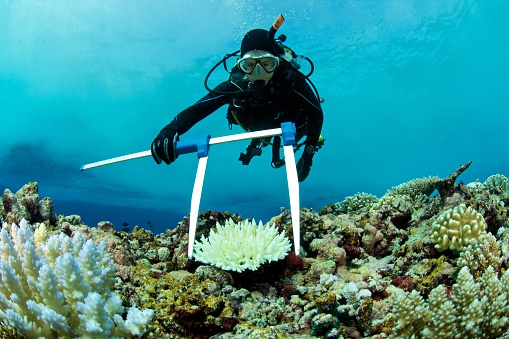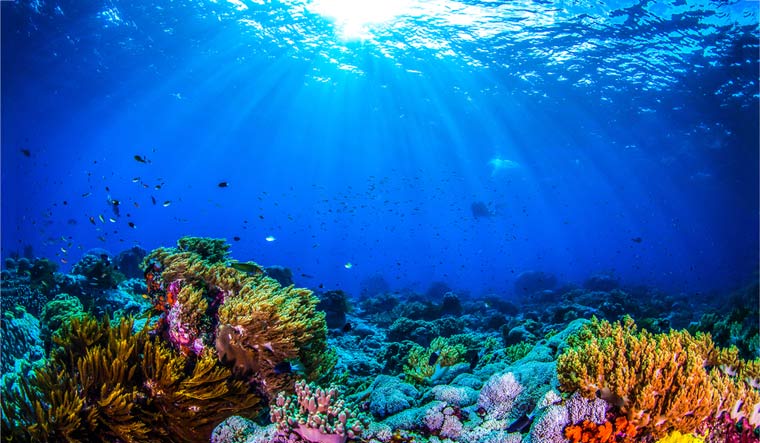The ocean calls out to me…
Frida stood rooted to her spot, fascinated by the vast stretch of calm deep water lying peacefully in front of her. As she observed the royal-blue waves gently crashing into each other, she felt her weariness and troubles ebb away, and a soothing peace washed over her. The ocean’s surface was dotted with gold from the setting sun, and as she lingered further on the deck of her ship, she wondered what the mysterious massive ocean held beneath its layers of cobalt, sapphire, and navy.
She’d watched a documentary recently about the technologies and scientific methods used to make discoveries about the ocean. The physical features of water, chemical composition, and the variety of life thriving underneath those waves were all described in detail in that documentary.
Then they discussed the machines and complicated methods to study all these. Her mind had grasped very little of the science involved because she was a literature major herself. Nonetheless, she still enjoyed the ocean even if she didn’t understand it. The mere fact that it was complicated and mysterious had a unique charm.
So many people like Frida are unaware that a whole branch of science focuses on studying oceans and their depths from many perspectives. Let’s see below which of these facts are new and which are somewhat familiar from watching movies or reading fiction.

Oceanography
The field that explores the wonders of the oceans in detail is quite exciting and, at times, dazzling. Writers and poets often use the beauty and depth of the sea to indicate the depth of human feelings. There is no doubt that these massive water bodies continue to mystify us despite a whole branch of science delving into them. Oceanography deals with the scientific study of oceans’ biological, chemical, and physical aspects, including their geography, paleontology, ecology, chemistry, etc.
The main branches of Oceanography or oceanology include:
Oceans are also studied from a chemical perspective to find out the reactions that occur within them, their related conditions and effects on the water, the chemical composition of the coral reef, ocean bed, etc., and the impact of chemical pollution on the ocean.
The biological side of oceanography contemplates the living organisms of the ocean and their interaction with each other and their environment. The ocean is home to a wide range of life, including fish, sea animals, plants, fungi, and other microorganisms.
Physical oceanography explores the physical properties and processes of the ocean like waves, currents, tides, atmosphere, sand, etc. It is an essential subfield because we can better understand the motion and action of oceans and predict their future.
Geology in this field investigates the landscape of the oceans in detail, like underwater mountains, trenches, etc., and helps map-making and predict earthquakes with the help of the tectonic plates’ theory. Another sub-branch worth interest is paleontology, which studies the fossils in the ocean bed to etch out a history of the life and events of maritime history.
Remember that all these fields are interconnected; for example, when studying ecosystems, we need to know the physical aspects, temperature, etc., best suited for life. When we discover a new fossil or shell, analysis of its chemical composition may make our research more fruitful.
Why study the ocean?
One cannot imagine the critical role of oceans in sustaining life on this planet. Many readers here would think, ‘hey, humans are land-dwellers. What have we got to do with the ocean?’
Here are some facts that highlight the significance of oceans in our lives:
The ocean produces more than fifty percent of the oxygen and stores fifty times more carbon dioxide than our atmosphere.
- The air we breathe
The ocean produces more than fifty percent of the oxygen and stores fifty times more carbon
dioxide than our atmosphere.
- Climate regulation
Oceans cover 70 percent of the Earth’s surface. They play a role in transporting heat from the equator to the poles and regulate weather and climate patterns.
- Food and Medicine
Besides fish and seafood, many other substances are extracted from the ocean, which are valuable ingredients for other foods like peanut butter or soymilk. Ten percent of human protein intake comes from the oceans. Many of these biochemicals in the sea serve as effective drugs in treating diseases like Alzheimer’s, cancer, and cardiovascular disease. Marine pharmacology explores the potential of chemicals from sea animals and plants to treat illness.
- Transportation
The oceans connect different continents of the Earth and serve as a passageway to trade and connection via ships.
- Recreation
several water sports like fishing, boating, kayaking, and whale watching provide unique entertainment and an opportunity to enlighten ourselves with information about the ocean.
- Economy
The ocean economy annually helps to earn billions. It not only strengthens the economy’s backbone with tourism, food and pharmaceuticals, and other valuable resources but also solves the increasing unemployment problem. Products of the ocean that have commercial value include pearls from oysters used in the jewelry industry and coral used in building materials and construction.
Linking Oceanography with Marine Biology
So, oceanography involves the study of the oceans from not only a biological but chemical, physical, geographical, and archeological perspective. On the other hand, marine biology comes under bio-oceanography. It explores the living organisms thriving in the ocean, their ecosystem, their interactions with each other and the environment, and aspects like marine nutrition.
Ten Technologies to Understand the Mysteries of the Ocean
High-frequency radar (HFR) is a unique technology for mapping ocean surface current and wave fields (along with other variables) over broad areas with high spatial and temporal resolution.
Sea gliders make oceanographic measurements traditionally collected by research vessels or moored instruments. They can move around or be fixed at one spot and can be commanded to alter their sampling strategies throughout a mission.
Marine telemetry implies attaching devices to animals to gather data. These telemetry devices, called tags, are fixed onto various marine species, from tiny salmon smolts to giant 150-ton whales. Tags are attached to the outside of an animal with clips, straps, or glue and are sometimes surgically inserted into an animal’s body. Research vessels, buoys, and satellites receive signals from the tags.
/Humpback-whale-and-calf-Cultura-getty-56a5f84e3df78cf7728ac019.jpg)
Telemetry tags describe the animal’s movements, and they can also pick up information about the animal (temperature, heart rate, oxygen levels), its behavior (vocalizations, breathing, tail beats), and its environment (sound, temperature, salinity, light).
These studies considerably enhance our perception of animals’ locations and how they answer to climate change and human-made disturbances. Telemetry data also helps to keep a count of the population so that we can figure out if the species is endangered or not. Marine telemetry is relatively cheaper than other technologies and can be used in areas that are difficult to study, such as the Arctic.
A drifter is an oceanographic device floating on the surface to investigate ocean currents and other parameters like temperature or salinity. Modern drifters are typically tracked by satellite, often GPS.
Drifters provide real-time information about ocean circulation. They make more accurate and frequent surface current velocity observations than possible from remote sensing measurements. Drifters are frequently used to collect data on biological oceanography, such as the transport of organisms.
Intelligent Buoy System (INBUS) was developed by the Korea Institute of Ocean Science and Technology (KIOST). Depending on the type of probes attached, the buoys may collect data on temperature (in the air, at the surface, and depth), wave height, wind speed, and direction, as well as current speed and direction. Fixed buoys can read the weather, detect tsunamis, and monitor tides.
Like the microphone collects sound in the air, a hydrophone detects acoustic signals under the water. Most hydrophones are based on a particular property of certain ceramics that produces a small electrical current when subjected to changes in underwater pressure. When submerged in the ocean, a ceramic hydrophone produces small-voltage signals over a wide range of frequencies as it is exposed to underwater sounds emanating from any direction. Hydrophones accurately measure ocean sounds by amplifying and recording these electrical signals.
Clod cards are a simple way of measuring relative water flow using blocks of plaster of Paris. As water flows over the obstructions, they dissolve. The faster the flow, the more they dissolve, a process called dissolution. Who would’ve thought such simple techniques could also help oceanography?
Sonar is a technique that uses sound propagation to navigate, measure distances, and communicate with or detect objects on or under the surface of the water, such as other vessels.
Sonar, short for Sound Navigation and Ranging, helps explore and map the ocean because sound waves travel farther in the water than radar and light waves. Scientists primarily use sonar to develop marine charts, locate underwater hazards to navigation, search for and map objects on the seafloor such as shipwrecks, and map the seafloor itself.
This technique is especially implied in studying the geography and archeology of the oceans.
“ROV” stands for a remotely operated vehicle; ROVs are unoccupied, highly maneuverable underwater machines that can use to explore ocean depths while operated by someone at the water surface.
ROVs are primarily used when humans diving is unreasonable or hazardous, such as working in deep water or investigating submerged threats. ROVs and AUVs carry equipment like video cameras, lights, and robotic arms to grab things. Where humans can’t go, these underwater robots help us safely study the ocean.
Satellites can observe the oceans in so many unique ways because of their altitude. They can easily cover all the oceans of the planet. Some of the dimensions of physical oceanography studied are sea surface temperatures, water circulation patterns, sea surface colors and locations of algal bloom, sea level changes and weather, tracking, and mapping. The satellites for sea color are called SeaWiFS.
Newer Technologies in Oceanography
Acoustic Doppler Current Profiler
An acoustic Doppler current profiler (ADCP) is a hydroacoustic current meter to evaluate ocean current velocities over a depth range using the Doppler effect of sound waves dispersed back from particles within the water column.
By interpreting the acoustic signals, this device calculates the ocean’s depth and the current. This device is used for rivers to measure the total flow of the current. It is beneficial for underwater vessels on marine expeditions to predict the ocean penetration and navigate the vessel.
ADCPs are also helpful in measuring wave dimensions like wave height, wave direction, and turbulence. The two critical rewards of ADCPs are the lack of moving parts that need biofouling and remote sensing, where a single, stationary instrument can measure the current profile over ranges exceeding 1000 m. These highlights permit long-time measurements of the ocean currents over a considerable segment of the water column.
CTD (Conductivity, Temperature, depth)
A CTD or sonde is an oceanography device to determine seawater’s electrical conductivity, temperature, and pressure. Depth is directly related to pressure, while conductivity is used to determine salinity. It is reliable because it gives highly resolved data.
Radioactive dating and environmental DNA
These techniques are purely biological and imply the hunt for fossils and DNA analysis. Coral reefs can be found with the help of carbon dating, the age of corals and shells. This tells us about the ocean bed’s history and aquatic life.
Environmental DNA refers to the extractable DNA collected by sending a volume of seawater through a filter with minor porosity. Many organisms, plants, and Micro life shed cells, fragments, and particles and excrete metabolic waste products into the water surrounding them. Analyzing the DNA in the cells could help us better understand marine life’s processes.
Magnetometer
A magnetometer is a passive instrument that measures changes in the Earth’s magnetic field. Ocean exploration can be used to survey cultural heritage sites such as ship and aircraft wrecks and characterize the seafloor’s geological features.
Under the sea, marine geophysicists, ocean engineers, and nautical archeologists use marine magnetometers to distinguish differences in the total magnetic field of the seafloor. Usually, the increased magnetization is caused by ferrous (unoxidized) iron on the seafloor, whether from a shipwrecked boat made of steel or a volcanic rock containing magnetite grains.
Expendable Bathythermographs
An eXpendable BathyThermograph (XBT) is a probe that is dropped from a ship and measures the temperature as it falls through the water. This torpedo-shaped device drops through the water column, sending the data back along the copper wire.
Limitations of Ocean Technology
The rapid development in oceanography is leading us to a better understanding of marine biology. However, some factors hinder our complete knowledge of the ocean. We must first be able to grasp the fact that the sea is vast and deep beyond our imagination. It’s a separate world with its archeology, hidden minerals, resources, and life forms. Humans have explored only a limited part of the oceans and are in for many more surprises.
One problem, for example, is the difficulty involved in studying the ocean bed. The pressure of the water is so high as you go deeper down that it becomes stressful to learn it with devices directly. Of course, indirect techniques like SONAR exist, but that’s all we’ve got right now.
Another problem is the cost—the fancier the technology, the more cost and maintenance it requires. Only well-off countries like the US can afford to invest in oceanography and arrange for escapades deep down the water. Developing countries like Pakistan have not yet achieved a milestone in oceanography due to the limited funds for this research.
Oceanography devices cause disturbances in everyday aquatic life and sea life behavior. This causes shifts in ecological balances and population sizes. Accidents with probes or devices could lead to species extinction or increased psychological stress in marine life.
Most of these devices have scalability issues due to noise and visual pollution in the water. These problems increase as you investigate further down the ocean.
The technology of any kind comes with a price, and it is only worth it if the technology is sustainable, reliable and accurately fulfills its purpose. There is still a need for a hefty investment and improvement in ocean technology to understand and unveil the ocean’s mysteries.
References:
- https://www.nationalgeographic.org/encyclopedia/oceanography/
- https://www.marineinsight.com/tech/11-technologies-that-are-used-to-study-and-understand-oceans/amp/
- https://prezi.com/y–n8eorjb6o/0-2-branches-of-oceanography/
- https://earthhow.com/what-is-oceanography/
Also, Read: Contribution of Marine Microalgae to Sustainability

Aniqa Mazhar is a graduate of QAU in Biochemistry. She has taught sciences to O levels and is currently planning for her MS in Food Technology. Aniqa’s hobbies are reading, watching movies, writing, calligraphy, long walks, and nature photography.

